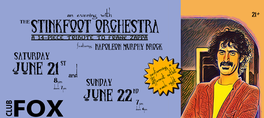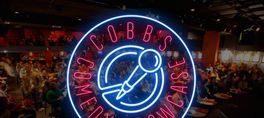Sat September 12, 2015
Chad and Curtis McKinney and Composers from the Center for Contemporary Music
SEE EVENT DETAILS
New electronic music by Chad McKinney and Curtis McKinney, John Bischoff, Maggi Payne, Chris Brown and James Fei.
Program will include
Maggi Payne: Through the Looking Glass (2015)
James Fei and Chris Brown: Duo (2015)
John Bischoff: Visibility Study (2015)
Chad McKinney and Curtis McKinney: Hyper Terrain II
Saturday, September 12, 2015
8:00 pm
Littlefield Concert Hall
Facebook Event:
https://www.facebook.com/events/148230455517418/
For detailed information, please visit the Music Now webpage:
http://musicnow.mills.edu
$15 general. $10 seniors, non-Mills students, and Mills alums
Tickets may be purchased at the door, or online at: http://www.boxofficetickets.com (keywords: Mills College)
Wheelchair accessible
Free parking on campus
Mills College
Music Department
5000 MacArthur Blvd
Oakland, CA 94613
-------------------
Maggi Payne:
Through the Looking Glass (2015
I’ve always been fascinated by water patterns, explored in this video through the looking glass of a camera lens which takes me closer or farther than I can reach while standing on shore, wading, swimming, or paddling a canoe. The magnification that the lens provides allows me to capture what I can’t observe with my own eyes due to physical obstructions, capabilities, or disruptions in the patterns that adding my body to the water creates. The patterns are illusive, changing in an instant due to variations in wind, light, currents, distance, and/or camera angle.
I wanted to capture patterns of rainfall, but the severe drought of 2015 in the San Francisco Bay Area prevented it, so the focus turned to bodies of water. Point Reyes’ Tomales Bay, Walker Creek, and North Beach, the ocean at Oxnard, Briones Reservoir, Petaluma River, and the bay’s harbors and surrounding areas became the primary sources.
The sounds I wished to hear in these locations were very delicate and were overwhelmed by sounds of helicopters, motorcycles, trucks, cars, trains, BART, and constant planes. I transformed the sounds of these and other human generated sounds into sounds that reflected the “natural” environment that I captured on video. The images are just as they were captured, without processing.
My earlier video Liquid Metal also focused on water patterns and the intrusion of human-created sounds into the wilds.
http://www.maggipayne.com
Sample video of Through the Looking Glass:
https://drive.google.com/a/mills.edu/file/d/0B2eOKoK-Uw2MZFp6ak9pSC1BSVU/view
John Bischoff:
Visibility Study (2015)
John Bischoff, electronics
Visibility Study turns the often used format of musician-processed-through-looping-pedal upside down. A noisy analog circuit becomes the player, and the looping component is derived from software analysis of the circuit signal rather than verbatim audio reproduction. Repeating musical "simulacra" of the circuit gestures are synthesized in overlapping layers using the analysis data. As repeating structures accumulate they are continually varied and developed, eventually migrating into tones tuned in "just" intonation. The piece ends with a return to noise but this time generated internally by chaotic software oscillations.
http://www.johnbischoff.com/
video/audio clips:
https://vimeo.com/user11765844/videos
https://soundcloud.com/johnleebischoff/
James Fei and Chris Brown:
Duo
James Fei, analog electronics and Chris Brown, digital electronics
The Duo consists of us playing our own solo pieces simultaneously. Since both pieces use feedback as a generative principle, and we are both avid improvisors, we adjust our performances so that both can be heard within the same space and time. We also share the Concert Hall's seven channel diffusion system to freely intermingle the sounds of our instruments.
James Fei:
Sine of Merit (2013—)
Sine of Merit is a series of works for analog electronics where the system is driven by multiple feedback loops. In addition to audio feedback—through reverb springs, transducer coupled objects and acoustically exciting the space, signals are also converted to control voltages and back, resulting in more oblique translations between signal types. The complex interplay between these loops result in an instrument that has a behavior of its own, oscillating between stable and chaotic states. The title is taken from a slogan of the Daven Company, which made precision attenuators and measurement equipment from the 1930's to the 1970's. I have always liked the dry engineering humor found in early advertisements of decidedly unexciting products, and the idea of a commendable sine wave seems appropriately absurd for my work.
http://www.jamesfei.com
Sample recording of Sine of Merit:
http://www.jamesfei.com/mp3/Fei_Sine_of_Merit_II_Excerpt.mp3
Chris Brown:
Know Nothing Network Music (2014–)
Uniformity is the bane of the digital medium, manifesting itself in the dominance of repetition, replication, and homogeneous textures in its musical results; networks may be used to combat this trend, instead of simply creating extended means of control. A “KnowNothing” computer network music uses rich specifications, loosely applied. It presumes no necessary behavior in response to data made available within the network, but assumes that performers will have a vested interest in using it. Any number of performers may play, either locally or at any distance through the internet, including a solo version in which the network is formed by the software running on a single computer, which feeds back data from the analysis of its own sound output and maps these to control parameters of its own sound generation algorithms.
http://www.cbmuse.com
Sample recording of Know Nothing Network Music:
http://cbmuse.com/wp-content/uploads/2014/12/Know-Nothing-Network-Music.mp3
Chad and Curtis McKinney:
Hyper Terrain II
Hyper Terrain II, is a network piece utilizing 3D graphics to create a shared space for rhythmic collaboration. Like many of our other works, we combine procedural generation with noise in an interactive environment. We took influence from many sources including the Principia Discordia, obscure anime with subtitles, various sour beers, group theory, and the inherit aesthetics of pure functional programming.
http://www.chadmckinneyaudio.com/
http://www.curtismckinney.com/
show less
Program will include
Maggi Payne: Through the Looking Glass (2015)
James Fei and Chris Brown: Duo (2015)
John Bischoff: Visibility Study (2015)
Chad McKinney and Curtis McKinney: Hyper Terrain II
Saturday, September 12, 2015
8:00 pm
Littlefield Concert Hall
Facebook Event:
https://www.facebook.com/events/148230455517418/
For detailed information, please visit the Music Now webpage:
http://musicnow.mills.edu
$15 general. $10 seniors, non-Mills students, and Mills alums
Tickets may be purchased at the door, or online at: http://www.boxofficetickets.com (keywords: Mills College)
Wheelchair accessible
Free parking on campus
Mills College
Music Department
5000 MacArthur Blvd
Oakland, CA 94613
-------------------
Maggi Payne:
Through the Looking Glass (2015
I’ve always been fascinated by water patterns, explored in this video through the looking glass of a camera lens which takes me closer or farther than I can reach while standing on shore, wading, swimming, or paddling a canoe. The magnification that the lens provides allows me to capture what I can’t observe with my own eyes due to physical obstructions, capabilities, or disruptions in the patterns that adding my body to the water creates. The patterns are illusive, changing in an instant due to variations in wind, light, currents, distance, and/or camera angle.
I wanted to capture patterns of rainfall, but the severe drought of 2015 in the San Francisco Bay Area prevented it, so the focus turned to bodies of water. Point Reyes’ Tomales Bay, Walker Creek, and North Beach, the ocean at Oxnard, Briones Reservoir, Petaluma River, and the bay’s harbors and surrounding areas became the primary sources.
The sounds I wished to hear in these locations were very delicate and were overwhelmed by sounds of helicopters, motorcycles, trucks, cars, trains, BART, and constant planes. I transformed the sounds of these and other human generated sounds into sounds that reflected the “natural” environment that I captured on video. The images are just as they were captured, without processing.
My earlier video Liquid Metal also focused on water patterns and the intrusion of human-created sounds into the wilds.
http://www.maggipayne.com
Sample video of Through the Looking Glass:
https://drive.google.com/a/mills.edu/file/d/0B2eOKoK-Uw2MZFp6ak9pSC1BSVU/view
John Bischoff:
Visibility Study (2015)
John Bischoff, electronics
Visibility Study turns the often used format of musician-processed-through-looping-pedal upside down. A noisy analog circuit becomes the player, and the looping component is derived from software analysis of the circuit signal rather than verbatim audio reproduction. Repeating musical "simulacra" of the circuit gestures are synthesized in overlapping layers using the analysis data. As repeating structures accumulate they are continually varied and developed, eventually migrating into tones tuned in "just" intonation. The piece ends with a return to noise but this time generated internally by chaotic software oscillations.
http://www.johnbischoff.com/
video/audio clips:
https://vimeo.com/user11765844/videos
https://soundcloud.com/johnleebischoff/
James Fei and Chris Brown:
Duo
James Fei, analog electronics and Chris Brown, digital electronics
The Duo consists of us playing our own solo pieces simultaneously. Since both pieces use feedback as a generative principle, and we are both avid improvisors, we adjust our performances so that both can be heard within the same space and time. We also share the Concert Hall's seven channel diffusion system to freely intermingle the sounds of our instruments.
James Fei:
Sine of Merit (2013—)
Sine of Merit is a series of works for analog electronics where the system is driven by multiple feedback loops. In addition to audio feedback—through reverb springs, transducer coupled objects and acoustically exciting the space, signals are also converted to control voltages and back, resulting in more oblique translations between signal types. The complex interplay between these loops result in an instrument that has a behavior of its own, oscillating between stable and chaotic states. The title is taken from a slogan of the Daven Company, which made precision attenuators and measurement equipment from the 1930's to the 1970's. I have always liked the dry engineering humor found in early advertisements of decidedly unexciting products, and the idea of a commendable sine wave seems appropriately absurd for my work.
http://www.jamesfei.com
Sample recording of Sine of Merit:
http://www.jamesfei.com/mp3/Fei_Sine_of_Merit_II_Excerpt.mp3
Chris Brown:
Know Nothing Network Music (2014–)
Uniformity is the bane of the digital medium, manifesting itself in the dominance of repetition, replication, and homogeneous textures in its musical results; networks may be used to combat this trend, instead of simply creating extended means of control. A “KnowNothing” computer network music uses rich specifications, loosely applied. It presumes no necessary behavior in response to data made available within the network, but assumes that performers will have a vested interest in using it. Any number of performers may play, either locally or at any distance through the internet, including a solo version in which the network is formed by the software running on a single computer, which feeds back data from the analysis of its own sound output and maps these to control parameters of its own sound generation algorithms.
http://www.cbmuse.com
Sample recording of Know Nothing Network Music:
http://cbmuse.com/wp-content/uploads/2014/12/Know-Nothing-Network-Music.mp3
Chad and Curtis McKinney:
Hyper Terrain II
Hyper Terrain II, is a network piece utilizing 3D graphics to create a shared space for rhythmic collaboration. Like many of our other works, we combine procedural generation with noise in an interactive environment. We took influence from many sources including the Principia Discordia, obscure anime with subtitles, various sour beers, group theory, and the inherit aesthetics of pure functional programming.
http://www.chadmckinneyaudio.com/
http://www.curtismckinney.com/
New electronic music by Chad McKinney and Curtis McKinney, John Bischoff, Maggi Payne, Chris Brown and James Fei.
Program will include
Maggi Payne: Through the Looking Glass (2015)
James Fei and Chris Brown: Duo (2015)
John Bischoff: Visibility Study (2015)
Chad McKinney and Curtis McKinney: Hyper Terrain II
Saturday, September 12, 2015
8:00 pm
Littlefield Concert Hall
Facebook Event:
https://www.facebook.com/events/148230455517418/
For detailed information, please visit the Music Now webpage:
http://musicnow.mills.edu
$15 general. $10 seniors, non-Mills students, and Mills alums
Tickets may be purchased at the door, or online at: http://www.boxofficetickets.com (keywords: Mills College)
Wheelchair accessible
Free parking on campus
Mills College
Music Department
5000 MacArthur Blvd
Oakland, CA 94613
-------------------
Maggi Payne:
Through the Looking Glass (2015
I’ve always been fascinated by water patterns, explored in this video through the looking glass of a camera lens which takes me closer or farther than I can reach while standing on shore, wading, swimming, or paddling a canoe. The magnification that the lens provides allows me to capture what I can’t observe with my own eyes due to physical obstructions, capabilities, or disruptions in the patterns that adding my body to the water creates. The patterns are illusive, changing in an instant due to variations in wind, light, currents, distance, and/or camera angle.
I wanted to capture patterns of rainfall, but the severe drought of 2015 in the San Francisco Bay Area prevented it, so the focus turned to bodies of water. Point Reyes’ Tomales Bay, Walker Creek, and North Beach, the ocean at Oxnard, Briones Reservoir, Petaluma River, and the bay’s harbors and surrounding areas became the primary sources.
The sounds I wished to hear in these locations were very delicate and were overwhelmed by sounds of helicopters, motorcycles, trucks, cars, trains, BART, and constant planes. I transformed the sounds of these and other human generated sounds into sounds that reflected the “natural” environment that I captured on video. The images are just as they were captured, without processing.
My earlier video Liquid Metal also focused on water patterns and the intrusion of human-created sounds into the wilds.
http://www.maggipayne.com
Sample video of Through the Looking Glass:
https://drive.google.com/a/mills.edu/file/d/0B2eOKoK-Uw2MZFp6ak9pSC1BSVU/view
John Bischoff:
Visibility Study (2015)
John Bischoff, electronics
Visibility Study turns the often used format of musician-processed-through-looping-pedal upside down. A noisy analog circuit becomes the player, and the looping component is derived from software analysis of the circuit signal rather than verbatim audio reproduction. Repeating musical "simulacra" of the circuit gestures are synthesized in overlapping layers using the analysis data. As repeating structures accumulate they are continually varied and developed, eventually migrating into tones tuned in "just" intonation. The piece ends with a return to noise but this time generated internally by chaotic software oscillations.
http://www.johnbischoff.com/
video/audio clips:
https://vimeo.com/user11765844/videos
https://soundcloud.com/johnleebischoff/
James Fei and Chris Brown:
Duo
James Fei, analog electronics and Chris Brown, digital electronics
The Duo consists of us playing our own solo pieces simultaneously. Since both pieces use feedback as a generative principle, and we are both avid improvisors, we adjust our performances so that both can be heard within the same space and time. We also share the Concert Hall's seven channel diffusion system to freely intermingle the sounds of our instruments.
James Fei:
Sine of Merit (2013—)
Sine of Merit is a series of works for analog electronics where the system is driven by multiple feedback loops. In addition to audio feedback—through reverb springs, transducer coupled objects and acoustically exciting the space, signals are also converted to control voltages and back, resulting in more oblique translations between signal types. The complex interplay between these loops result in an instrument that has a behavior of its own, oscillating between stable and chaotic states. The title is taken from a slogan of the Daven Company, which made precision attenuators and measurement equipment from the 1930's to the 1970's. I have always liked the dry engineering humor found in early advertisements of decidedly unexciting products, and the idea of a commendable sine wave seems appropriately absurd for my work.
http://www.jamesfei.com
Sample recording of Sine of Merit:
http://www.jamesfei.com/mp3/Fei_Sine_of_Merit_II_Excerpt.mp3
Chris Brown:
Know Nothing Network Music (2014–)
Uniformity is the bane of the digital medium, manifesting itself in the dominance of repetition, replication, and homogeneous textures in its musical results; networks may be used to combat this trend, instead of simply creating extended means of control. A “KnowNothing” computer network music uses rich specifications, loosely applied. It presumes no necessary behavior in response to data made available within the network, but assumes that performers will have a vested interest in using it. Any number of performers may play, either locally or at any distance through the internet, including a solo version in which the network is formed by the software running on a single computer, which feeds back data from the analysis of its own sound output and maps these to control parameters of its own sound generation algorithms.
http://www.cbmuse.com
Sample recording of Know Nothing Network Music:
http://cbmuse.com/wp-content/uploads/2014/12/Know-Nothing-Network-Music.mp3
Chad and Curtis McKinney:
Hyper Terrain II
Hyper Terrain II, is a network piece utilizing 3D graphics to create a shared space for rhythmic collaboration. Like many of our other works, we combine procedural generation with noise in an interactive environment. We took influence from many sources including the Principia Discordia, obscure anime with subtitles, various sour beers, group theory, and the inherit aesthetics of pure functional programming.
http://www.chadmckinneyaudio.com/
http://www.curtismckinney.com/
read more
Program will include
Maggi Payne: Through the Looking Glass (2015)
James Fei and Chris Brown: Duo (2015)
John Bischoff: Visibility Study (2015)
Chad McKinney and Curtis McKinney: Hyper Terrain II
Saturday, September 12, 2015
8:00 pm
Littlefield Concert Hall
Facebook Event:
https://www.facebook.com/events/148230455517418/
For detailed information, please visit the Music Now webpage:
http://musicnow.mills.edu
$15 general. $10 seniors, non-Mills students, and Mills alums
Tickets may be purchased at the door, or online at: http://www.boxofficetickets.com (keywords: Mills College)
Wheelchair accessible
Free parking on campus
Mills College
Music Department
5000 MacArthur Blvd
Oakland, CA 94613
-------------------
Maggi Payne:
Through the Looking Glass (2015
I’ve always been fascinated by water patterns, explored in this video through the looking glass of a camera lens which takes me closer or farther than I can reach while standing on shore, wading, swimming, or paddling a canoe. The magnification that the lens provides allows me to capture what I can’t observe with my own eyes due to physical obstructions, capabilities, or disruptions in the patterns that adding my body to the water creates. The patterns are illusive, changing in an instant due to variations in wind, light, currents, distance, and/or camera angle.
I wanted to capture patterns of rainfall, but the severe drought of 2015 in the San Francisco Bay Area prevented it, so the focus turned to bodies of water. Point Reyes’ Tomales Bay, Walker Creek, and North Beach, the ocean at Oxnard, Briones Reservoir, Petaluma River, and the bay’s harbors and surrounding areas became the primary sources.
The sounds I wished to hear in these locations were very delicate and were overwhelmed by sounds of helicopters, motorcycles, trucks, cars, trains, BART, and constant planes. I transformed the sounds of these and other human generated sounds into sounds that reflected the “natural” environment that I captured on video. The images are just as they were captured, without processing.
My earlier video Liquid Metal also focused on water patterns and the intrusion of human-created sounds into the wilds.
http://www.maggipayne.com
Sample video of Through the Looking Glass:
https://drive.google.com/a/mills.edu/file/d/0B2eOKoK-Uw2MZFp6ak9pSC1BSVU/view
John Bischoff:
Visibility Study (2015)
John Bischoff, electronics
Visibility Study turns the often used format of musician-processed-through-looping-pedal upside down. A noisy analog circuit becomes the player, and the looping component is derived from software analysis of the circuit signal rather than verbatim audio reproduction. Repeating musical "simulacra" of the circuit gestures are synthesized in overlapping layers using the analysis data. As repeating structures accumulate they are continually varied and developed, eventually migrating into tones tuned in "just" intonation. The piece ends with a return to noise but this time generated internally by chaotic software oscillations.
http://www.johnbischoff.com/
video/audio clips:
https://vimeo.com/user11765844/videos
https://soundcloud.com/johnleebischoff/
James Fei and Chris Brown:
Duo
James Fei, analog electronics and Chris Brown, digital electronics
The Duo consists of us playing our own solo pieces simultaneously. Since both pieces use feedback as a generative principle, and we are both avid improvisors, we adjust our performances so that both can be heard within the same space and time. We also share the Concert Hall's seven channel diffusion system to freely intermingle the sounds of our instruments.
James Fei:
Sine of Merit (2013—)
Sine of Merit is a series of works for analog electronics where the system is driven by multiple feedback loops. In addition to audio feedback—through reverb springs, transducer coupled objects and acoustically exciting the space, signals are also converted to control voltages and back, resulting in more oblique translations between signal types. The complex interplay between these loops result in an instrument that has a behavior of its own, oscillating between stable and chaotic states. The title is taken from a slogan of the Daven Company, which made precision attenuators and measurement equipment from the 1930's to the 1970's. I have always liked the dry engineering humor found in early advertisements of decidedly unexciting products, and the idea of a commendable sine wave seems appropriately absurd for my work.
http://www.jamesfei.com
Sample recording of Sine of Merit:
http://www.jamesfei.com/mp3/Fei_Sine_of_Merit_II_Excerpt.mp3
Chris Brown:
Know Nothing Network Music (2014–)
Uniformity is the bane of the digital medium, manifesting itself in the dominance of repetition, replication, and homogeneous textures in its musical results; networks may be used to combat this trend, instead of simply creating extended means of control. A “KnowNothing” computer network music uses rich specifications, loosely applied. It presumes no necessary behavior in response to data made available within the network, but assumes that performers will have a vested interest in using it. Any number of performers may play, either locally or at any distance through the internet, including a solo version in which the network is formed by the software running on a single computer, which feeds back data from the analysis of its own sound output and maps these to control parameters of its own sound generation algorithms.
http://www.cbmuse.com
Sample recording of Know Nothing Network Music:
http://cbmuse.com/wp-content/uploads/2014/12/Know-Nothing-Network-Music.mp3
Chad and Curtis McKinney:
Hyper Terrain II
Hyper Terrain II, is a network piece utilizing 3D graphics to create a shared space for rhythmic collaboration. Like many of our other works, we combine procedural generation with noise in an interactive environment. We took influence from many sources including the Principia Discordia, obscure anime with subtitles, various sour beers, group theory, and the inherit aesthetics of pure functional programming.
http://www.chadmckinneyaudio.com/
http://www.curtismckinney.com/
show less
Date/Times:
5000 MacArthur Blvd., Oakland, CA 94613
The Best Events
Every Week in Your Inbox
From Our Sponsors
UPCOMING EVENTS
Great suggestion! We'll be in touch.
Event reviewed successfully.









